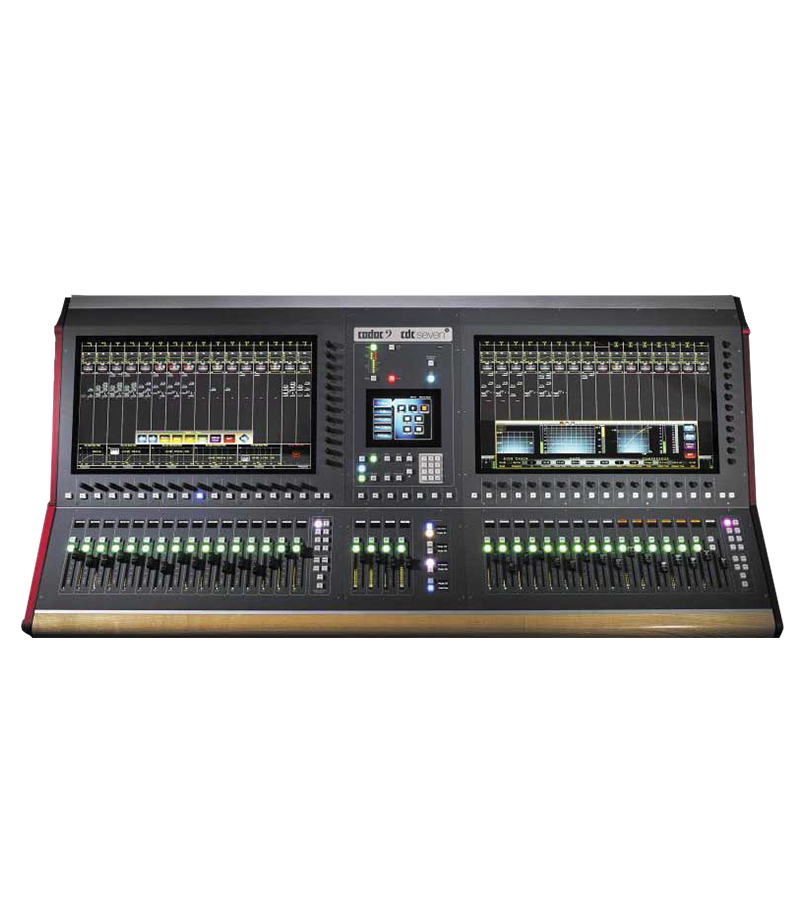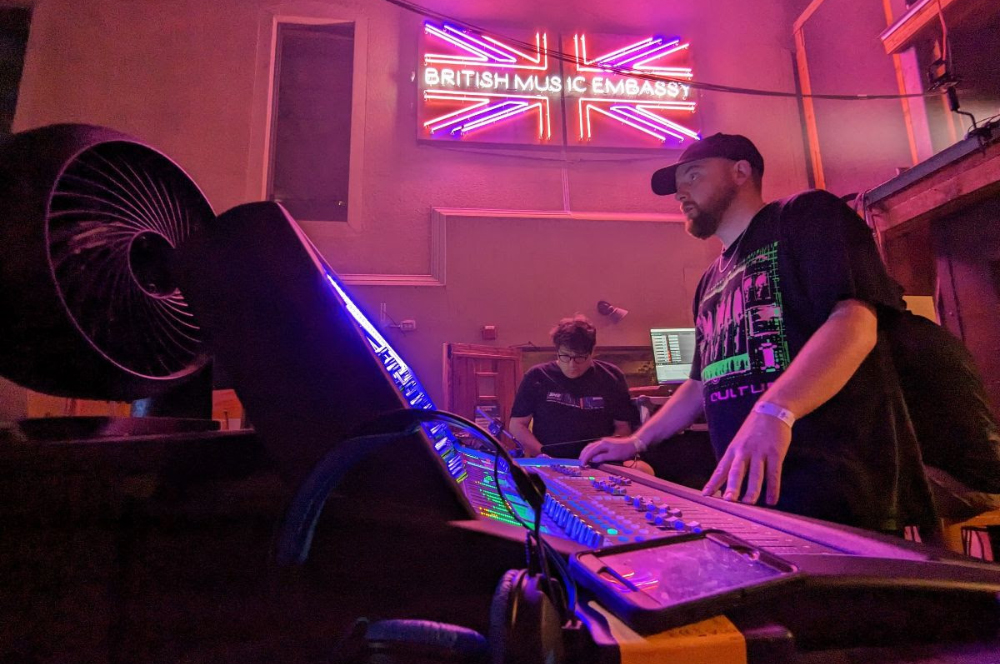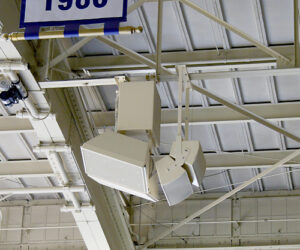When we talk of “large frame” consoles, older analog units with channel counts of 40 inputs or more come to mind because they actually had very large frames loaded with channel strips.
In today’s digital world, however, we’re usually referring to a console that can professionally handle a large production, even if physically it’s not all that sizeable, because most use layers of fader banks to access additional channels and functions like aux sends on faders.
It’s not uncommon to see newer digital models measuring only a few feet in width that can handle 40 or more channels, where in the analog world a 40-input console might be six or more feet wide. Digital consoles have also eliminated the need to carry heavy racks loaded with outboard gear like EQs and effects.
Most digital consoles can operate on a network, allowing multiple channels to travel down a small Ethernet, coax or fiber optic cable. Inputs and outputs can be located remotely in stage boxes that are easily linked via lighter cable, eliminating the need for heavy copper analog snakes. In addition, multiple audio devices such as additional consoles and recording units also have easy access to the network.
My company also utilizes networked computers for live multitrack recording, archival recordings, and virtual sound check. Coupled with the full recall capability of digital consoles, virtual sound check insures that mix engineers don’t have to start from scratch at every gig with the same band, and can “dial in” the band before they even arrive at the venue.
Another feature many digital consoles now provide is offline editing, which is the ability to set up and configure the console for a specific act, load the showfile on a thumb drive, and then transfer the settings at a later time to a console. This has been a boon for touring folks can have multiple showfiles for different consoles, and when they get to the venue, simply upload their parameters into the given console without having to spend time labeling, adjust and configuring parameters at every tour stop.
My favorite digital console capability is remote access via tablets and laptops. Many models allow engineers to connect via Wi-Fi to remotely control a variety of parameters, allowing them to step away and listen to/adjust the mix in different locations throughout the coverage area.
When doing the house mix, it’s great to be able to move around to hear what various sections of the audience are hearing and be able to optimize. It’s also much easier to dial in a monitor mix while standing on stage, hearing what the performers are hearing.
Following is a look at a number of recent digital consoles that deliver larger-format capability. While some are not necessarily physically imposing, all have the facilities to handle bigger, more complex events.
Enhanced Listing
Allen & Heath Avantis
allen-heath.com

The third mixer based on Allen & Heath’s 96 kHz XCVI FPGA engine, Avantis puts TEC Award-winning technology in a 64-channel/42 configurable bus console, with dual full HD touchscreens, a flexible workflow with Continuity UI, extensive I/O options, and a rugged full metal chassis. Avantis dPack adds internal dLive processing without burning FX slots, third-party gear hassles, or issues with latency or phase coherency.
Continuity UI allows engineers to see and instantly interact with more of what matters, enabling a seamless connection between the physical controls and the displays. The faders react on touch to immediately highlight the active channels for instant visual feedback. Inspired by the tubular exoskeletons of the latest generation of superbikes, those sleek curves are all metal – super tough, but light in weight.
Technology Focus: In addition to DEEP emulations, Avantis dPack also delivers Dyn8, a powerful processor offering four bands of dynamic EQ and four bands of multiband compression. Handy for adding “sonic glue” to a mix, dPack enables 16 Dyn8 engines for inserting on input and mix channels.
Of Note: The SLink connection on Avantis allows extreme flexibility by connecting to the entire range of Allen & Heath audio expander hardware (including AB/AR 48 kHz stage boxes with sample rate conversion). Add a Dante card for even more networked system options with dedicated Dante expanders like the DT168 and DT164-W.

Key Specifications
Faders: 24 faders, 6 layers (144 fader strips)
Mix Inputs: 88 (64 plus 12 stereo FX returns) with full 96 kHz processing
Aux/Group: 42 mix outputs with full processing
Matrix: User configurable 42 bus architecture
FX: 12 Stereo (dPack option adds DEEP/Dyn processing) | DCA: 16
Mains: LR, LR + Mono Sum, LR + M, LCR
Also: 2 x 128 x 128 96 kHz option slots, 64 channels of Automatic Mic Mixing (AMM)
Screen: 2 x 15.6-inch full HD capacitive touch screens with gesture control
Local I/O: 12 XLR inputs, 12 XLR outputs, 1 stereo AES in, 2 stereo AES out
Stage Boxes: GX4816, DX012, DX32, DX168, DT168 Dante, DX164-W, DT164-W Dante, DX Hub, AR2412, AB168, AR84. Also fully compatible with all dLive I/O cards (including 96 kHz Dante 128 x 128, Waves, etc.), IP controllers, and ME personal monitoring.
Physical: 36.1 x 24.7 x 10.6 inches, 57.4 pounds
Standard Listings
DiGiCo Quantum Range (Quantum338)
digico.biz
Faders: 38
Mix Inputs: 128
Aux/Group: 64
Matrix: 24 x 24
FX: 24
DCA: 24
GEQ: 24
Screens: Three 17-inch touch screens
App: Quantum App (iPad)
Local I/O: 8 + 8 analog, 4 stereo AES/EBU, 6 sets of MADI ports, 2 DMI card slots
Stage Boxes: SD Rack, SD-MiNi, SD-NANO, D2-Rack, D-Rack
Options: DMI Card options for ADC, AES, AMM, DAC, Dante, Dante64@96, Hydra 2, Klang, MADI B, MADI C, ME, Mic, Waves
Also: HTL (Hidden Til Lit) Technology, overview monitor output
Physical: 62.8 x 31.7 x 19 inches, 154.3 pounds
Additional Models In Series: Quantum852, 338T, 225, 7, 7B and 7T, 5 and 5B
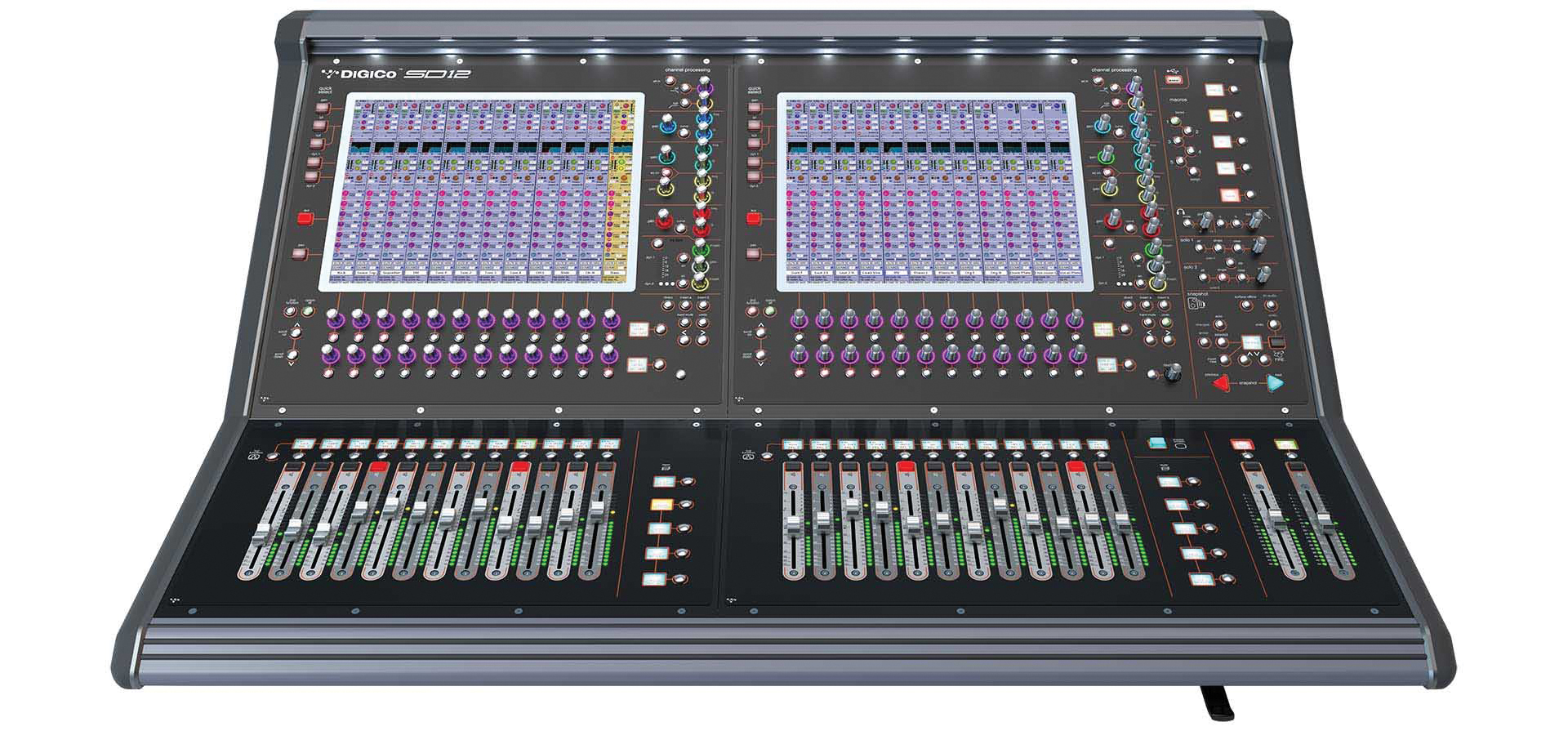
Lawo mc²56 With A__UHD Core Engine
lawo.com
Faders: Remote stand-alone frames of 16 faders (16 to 144 faders)
Mix Inputs: 768 inputs and 256 summing busses with full 96 kHz processing, up to 32 surround channels
Aux/Group: up to 128 and buses, up to 96 groups, up to 32 automix groups
VCA: Up to 128
Mains: Up to 96 main sums
App: mxGUI remote control via laptop/tablet PC
Screen: Up to three 21.5-inch HD touch screens (depends on frame size)
Local I/O: (control surface) 16 XLR mic/line inputs, 16 XLR line outputs, 8 AES3 inputs and outputs, 8 GPIOs, plus local MADI (SFP)
Stage Boxes: A__UHD Core, A__mic8, A__digital64, A__madi6, A__stage64, A__stage80
Physical: 91.9 in (64 frames wide) down to 23.5 in (16 frames wide); 207 lbs (64 frames) down to 62 lbs (16 frames)
Additional Models: mc² 36, mc² 96

Avid VENUE S6L (S6L-32D)
avid.com
Faders: 32 + 2
Mix Inputs: 192
Aux/Group: 96
Matrix: 24 x 24
DCA: 24
GEQ: 32
Screens: Four 12-inch touch screens
Local I/O: 8 + 8 analog XLR, 4 + 4 AES/EBU
Stage Boxes: Stage 32, Stage 64
Card Options: Ethernet AVB, Dante, MADI, Aviom, Thunderbolt
Also: Direct Waves and AAX plugins, 128 tracks of Pro Tools
built in
Physical: 51 x 31 x 15 inches, 155 pounds
Additional Models: S6L-48D, S6L-24D, S6L-24C, S6L-16C
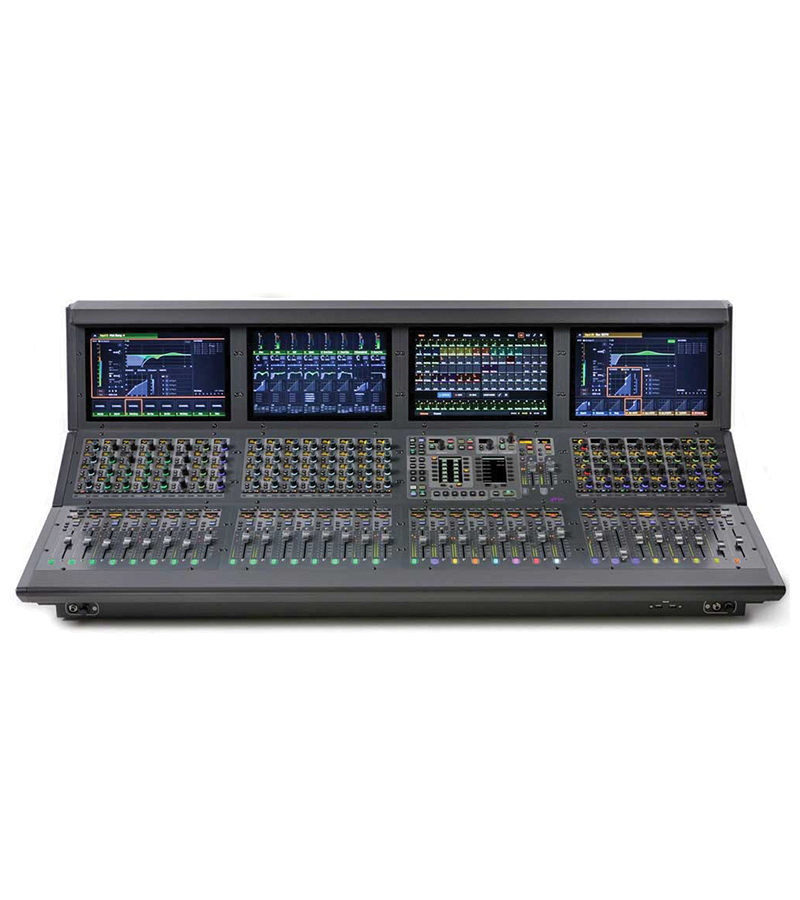
SSL Live L650
solidstatelogic.com
Faders: 36
VCA: 48
Total Mix Paths (Inputs/Aux/Stems/Masters): 312 full processing paths
Matrix: 4 x 32 input, 36 outputs
FX: Up to 96 instances at one time
Screens: 19-inch multi-touch screen, optional arm mounted external screens
Local I/O: 16 x mic/line, 16 outputs, 2 x headphones; 4 pairs x AES/EBU; 6 x coax & 2 x optic MADI ports
Stage Boxes: ML 32.32 (analog), BL II.2 (MADI), Network I/O MADI-Bridge, D 32.32 (AES/EBU)
Physical: 54.2 inches wide, 188 pounds
Additional Models In Series: L550 Plus, L350 Plus, L200 Plus, L100 Plus
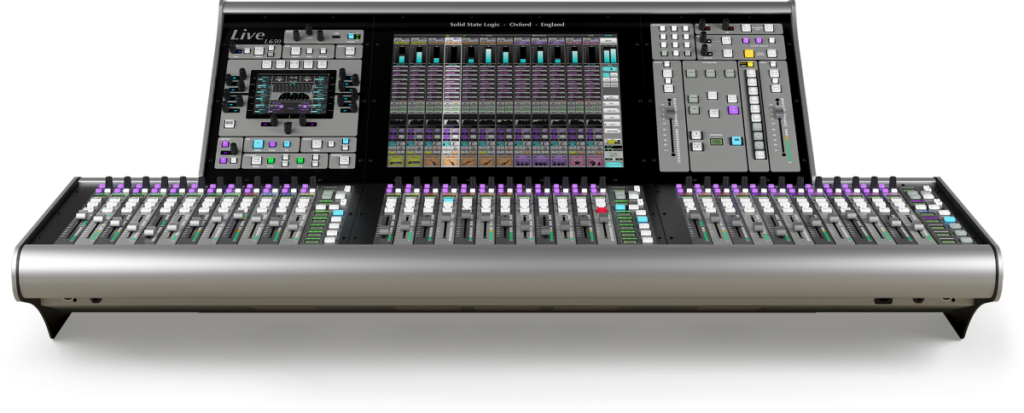
Waves eMotion LV1
waves.com
Faders: Up to 32+2 Faders, FIT Controller
Mix Inputs: 128
Aux/Group: up to 24/8
Matrix: 8
FX: 8
DCA: 16
Screens: Compatible with up to four touch screens
App: Mixer (MyFOH), Personal Monitoring (MyMON), Scene recall (mRecall)
Local I/O: Connect to any SoundGrid-compatible I/O or server
Stage Boxes: Patch up to 16 hardware and software SoundGrid I/Os; also share I/Os – stage boxes, DAWs, computers – between multiple LV1 systems
Physical: Depends on configuration
Additional Models In Series: eMotion LV1 32-channel and 16-channel
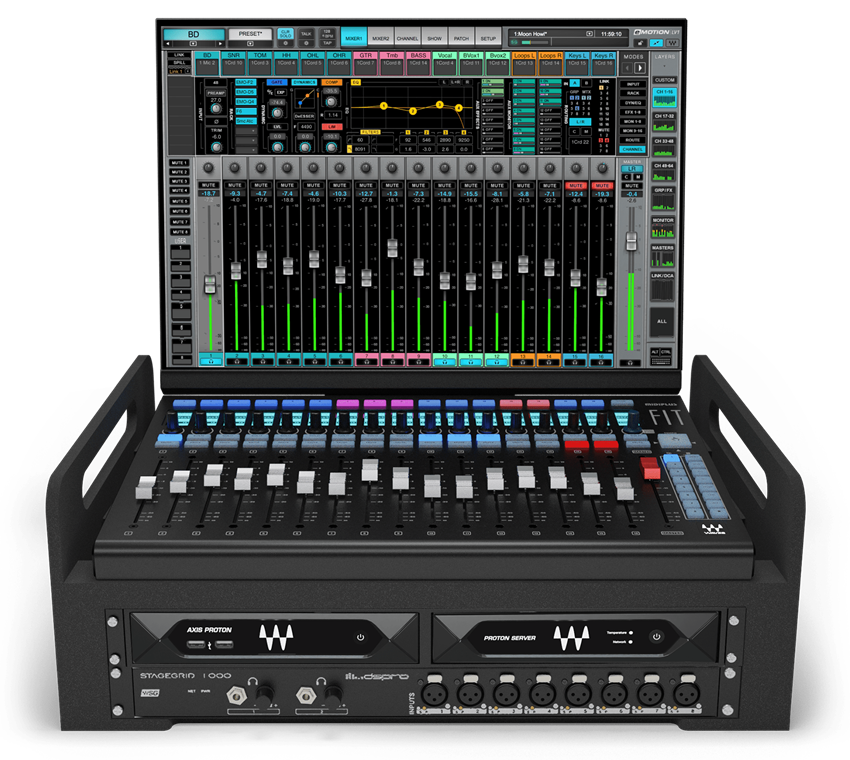
Yamaha RIVAGE PM5
usa.yamaha.com
Faders: 38 (12+12+12+2)
Mix Inputs: 120
Aux/Group: 48 (DSP-RX), 72 (DSP-RX-EX)
Matrix: 36 (DSP-RX-EX); 24 (DSP-RX)
FX: 45 types, up to 384 / 512 instances depending on DSP configuration
DCA: 24
GEQ: 48
App: StageMix (iPad)
Screens: Three 15-inch touch screens
Local I/O: 8 + 8 analog XLR, 4 + 4 AES/EBU
Stage Box: DSP-RX-EX; DSP-RX
MY Cards: Dante, MADI, Aviom, many others
Also: Neve inserts, TC and Eventide FX, SILK mic preamp
Physical: 56.9 x 25.3 x 16.2 inches, 93 pounds
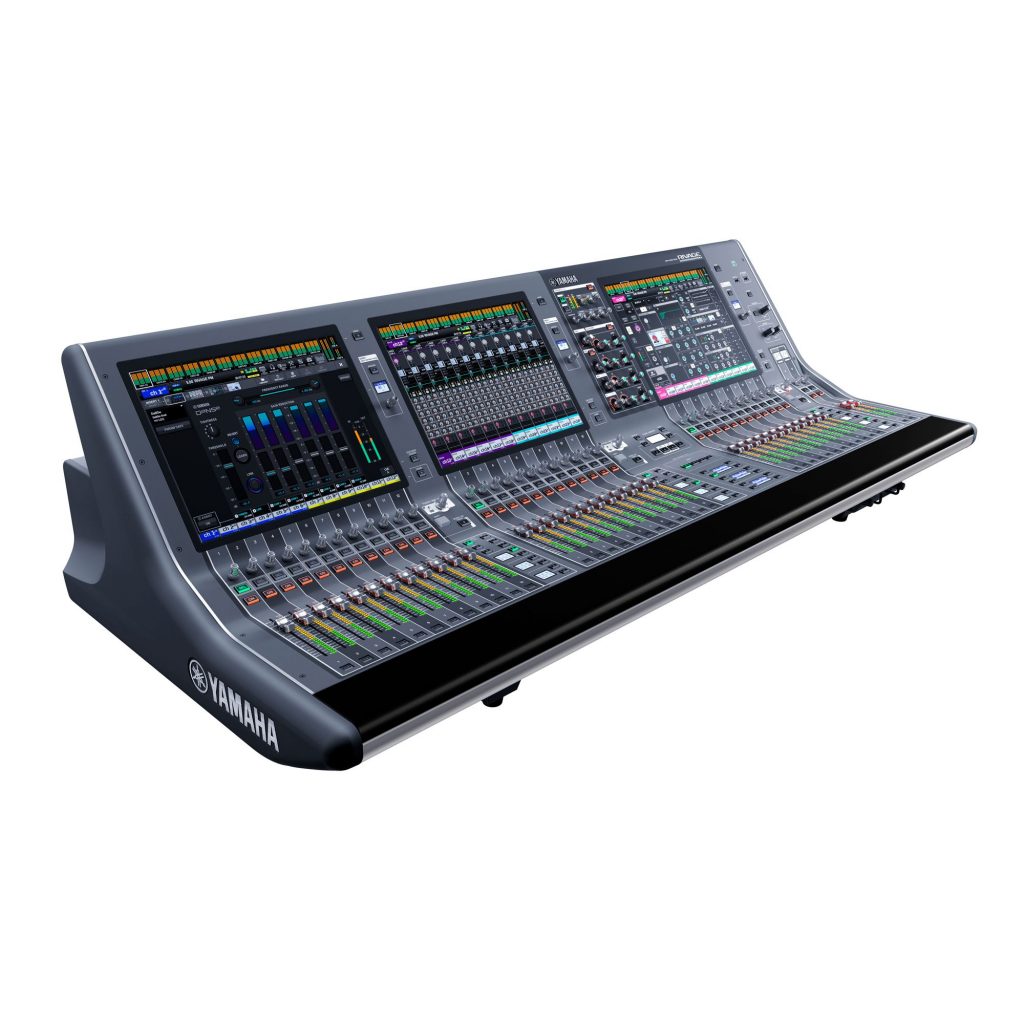
Stage Tec AURUS Platinum
stagetec.com
Faders: Up to 96
Mix Inputs: 300
Aux/Group: 128
Matrix: 32 x 32
DCA: 24
GEQ: 32
Screens: Five 19-inch metering and one 10-inch
touch screen
Stage Boxes: NEXUS Base Device modular frames
Also: RAVENNA networking technology, 32-bit TrueMatch A/D mic preamp conversion
Physical: 54 x 42 x 41 inches, 90 pounds
Additional Models: AURUS, CRESCENDO, CRESCENDO Platinum, AURATUS
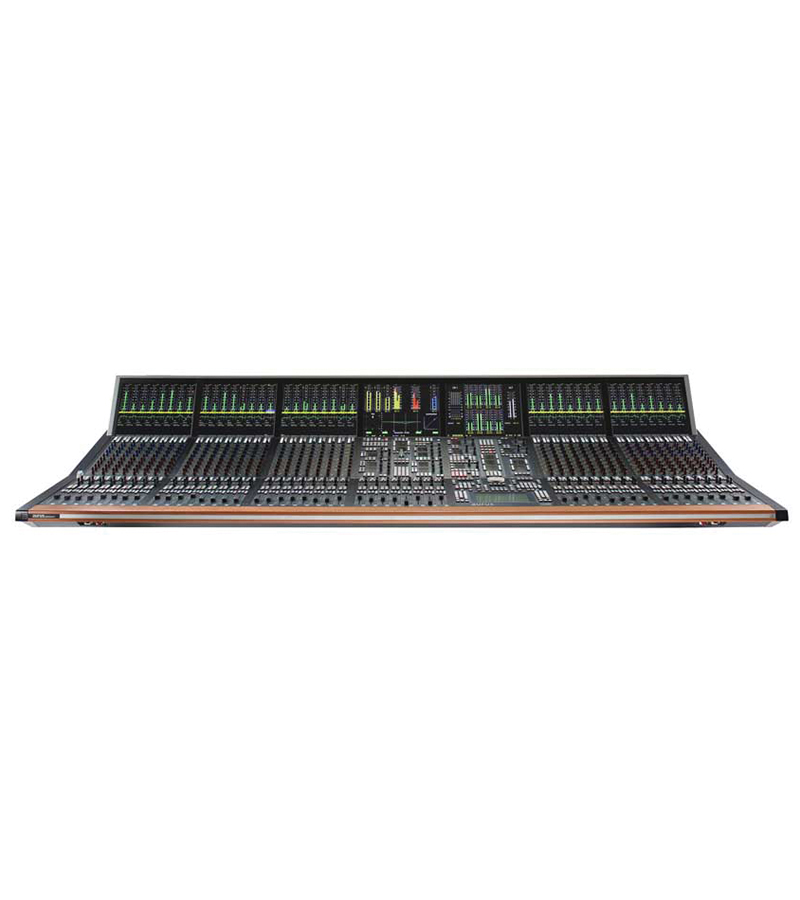
Midas PRO X
midasconsoles.com
Faders: 12 + 10 + 4
Mix Inputs: 144
Aux/Group: 72
Matrix: 24
FX: Up to 48
DCA: 10
GEQ: 36
Screens: Two 15-inch
App: MixTender 2 (iPad), PalmMix (iOS)
Local I/O: 8 + 8 analog XLR, 4 + 4 AES/EBU
Stage Boxes: DL151 through 155, DL251&252, DL351, DL451
Options: DN9650 & DN9652 MADI/Dante/CobraNet/
ES bridges
Also: 3-way KVM switch
Physical: 54 x 37 x 17 inches, 213 pounds
Additional Models In Series: PRO3, PRO6, PRO9
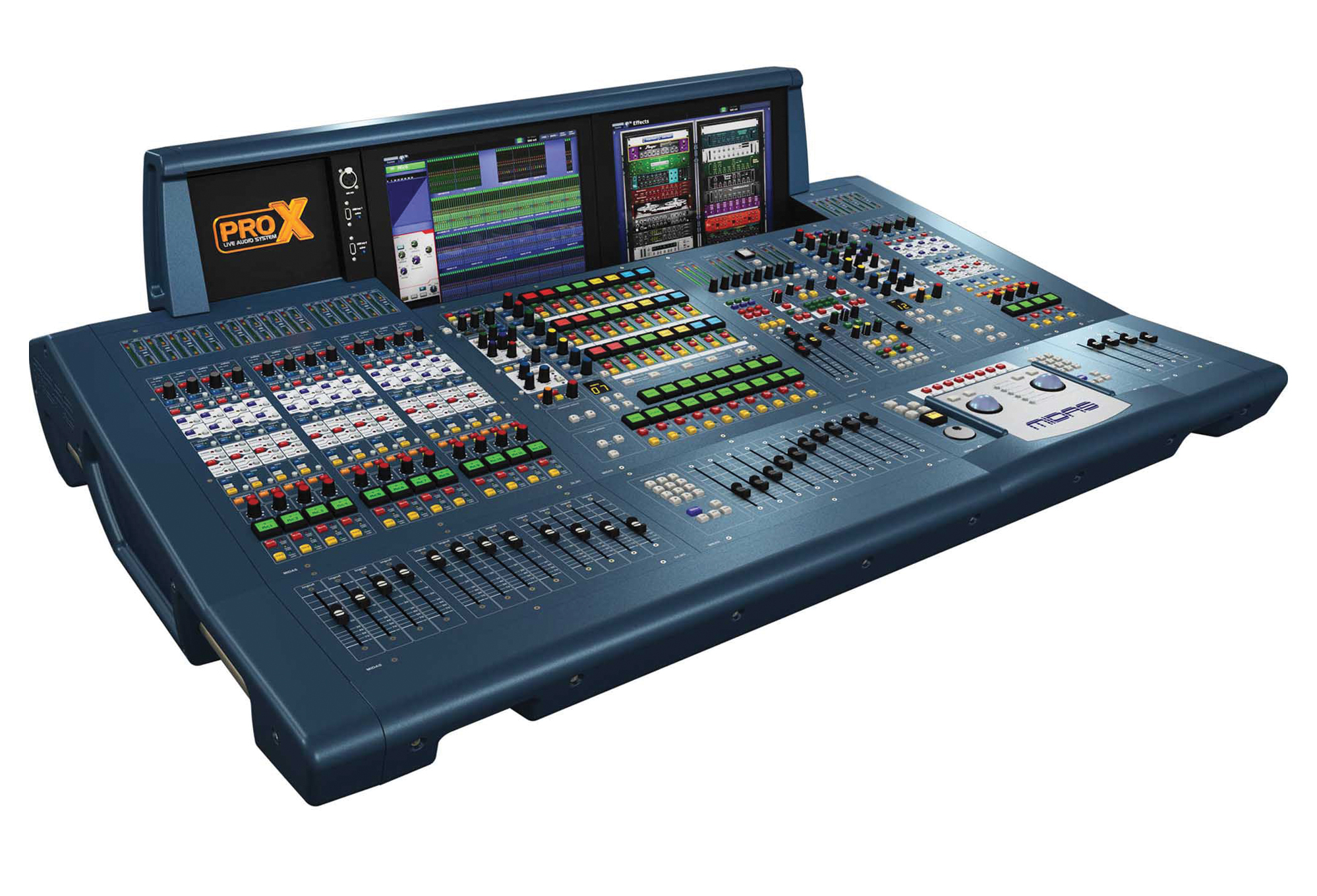
Soundcraft Vi1000
soundcraft.com
Faders: 20
Mix Inputs: 96
Aux/Group: 24 stereo/mono
Matrix: 16 stereo/mono
FX: 4 Lexicon stereo
DCA: 16
GEQ: 24
Screens: Two 12-inch Vistonics screens
App: ViSi (iPad)
Local I/O: 16 inputs and 16 outputs, 2 stereo AES/EBU
Stage Boxes: Vi Stagebox, Compact Stagebox, Mini Stagebox
Options: Dante, MADI, EtherSound, CobraNet, ADAT, Aviom, Blu Link
Also: Dante connectivity standard, vMIX automatic mic mixing, UA real-time plugins
Physical: 33.2 x 31.6 x 13.8 inches, 55 pounds
Additional Models In Series: Vi2000, Vi3000, Vi5000, Vi7000
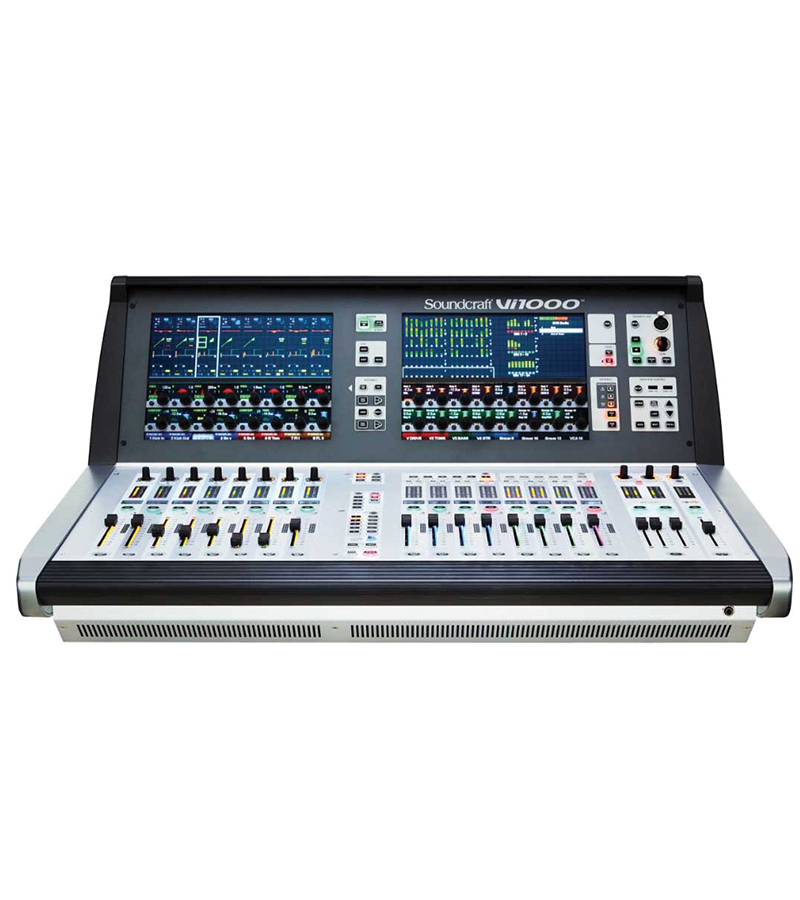
Enhanced Listing
Allen & Heath dLive CTi1500
allen-heath.com
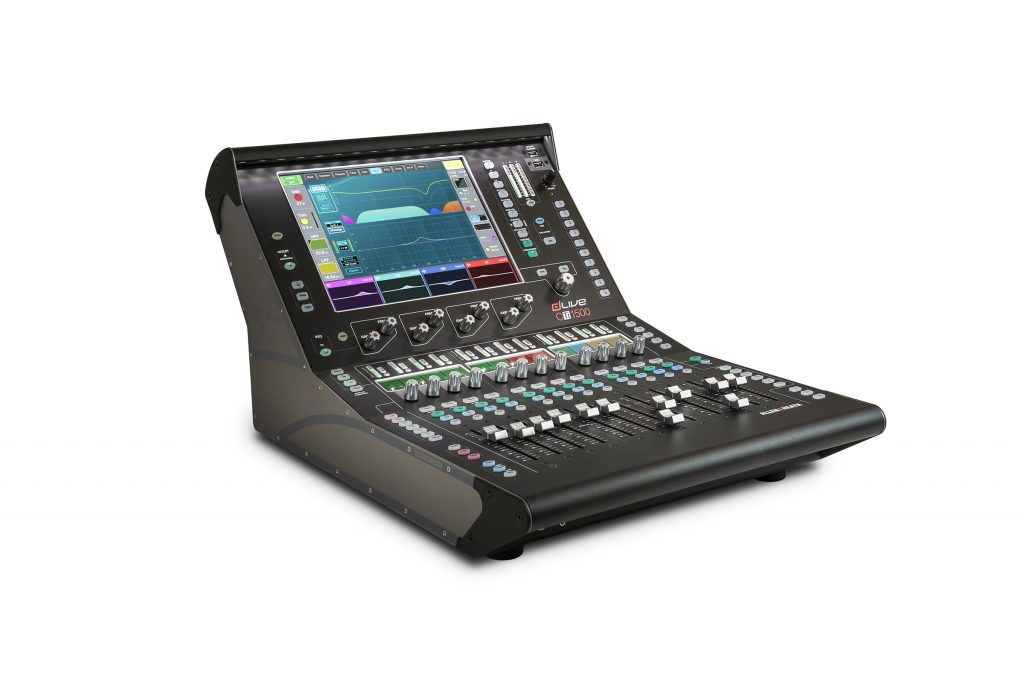
dLive is Allen & Heath’s flagship mixing system. The power of dLive emanates from the XCVI core, pioneered by the Allen & Heath R&D team using next generation FPGA technology, with 36 parallel virtual processing cores generating enough power for 160 x 64 channels of processing at 96 kHz. From the lightweight 25.4-pound rack-mountable CTi1500 up to the largest S7000, all dLive surfaces are fully compatible with dLive C Class and S Class MixRacks.
Seven control surfaces and seven MixRacks, support for leading audio networking protocols like Dante, MADI, and Waves, plug and play ME personal monitor mixers, an array of compact TCP/IP network remotes, I/O expanders, iPad and Android apps, and Mac and PC online/offline editor software all combine to rethink and redefine the ultimate in scalable and versatile audio mixing systems.
Technology Focus: All dLive systems utilize the XCVI FPGA core to calculate over 10,000 cross points per sample, while the FPGA router has capacity for 3,000 x 3,000 audio paths. XCVI (25 billion operations per second) allows dLive to deliver 128 processing inputs and 16 stereo FX returns, a configurable 64-bus architecture, variable bit depth for exceptional precision and noise performance and more.
Of Note: The DEEP processing architecture within dLive embeds compressors and processing emulations directly within input and mix channels. An array of algorithms, including graphic EQs, compressors and a 64-channel Automatic Mic Mixer (AMM) can be inserted on the fly without burning FX slots.
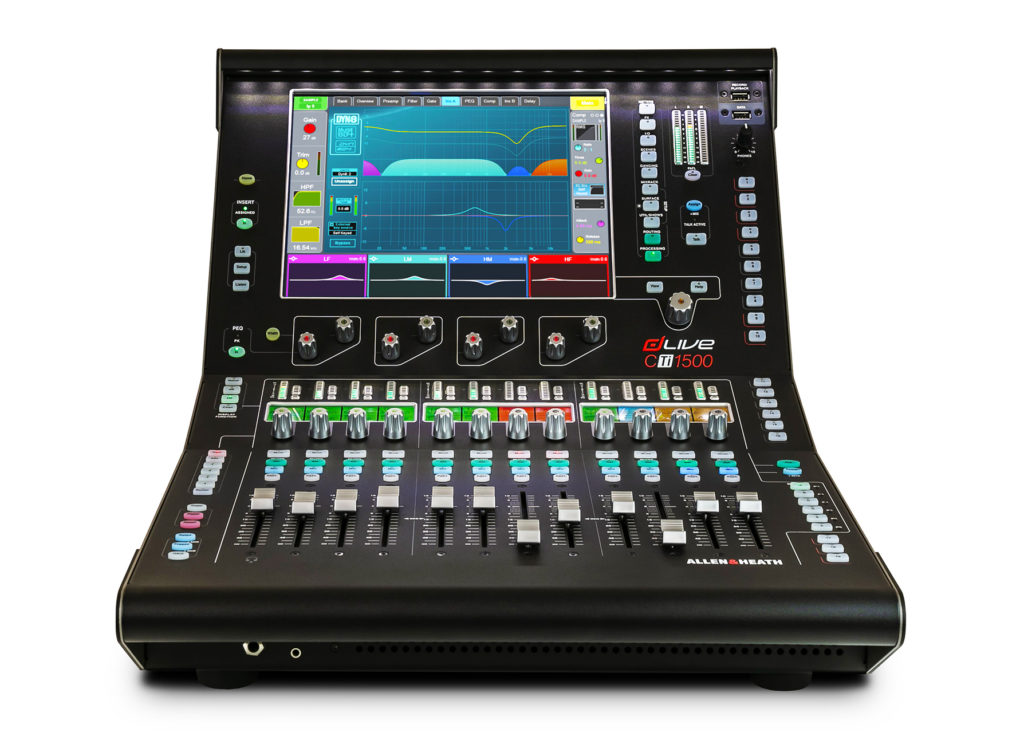
Key Specifications:
Faders: 12 faders, 6 layers (72 fader strips)
Mix Inputs: 160 (128 plus 16 stereo FX returns) with 96 kHz processing
Aux/Group: 64 mix outputs with full processing
Matrix: User configurable 64 bus architecture
FX: 16 stereo | DCA: 24
Mains: LR, LCR, LR+Msum, LR+M and 5.1 Mains mode
App: dLive Director for macOS and PC; MixPad iOS; OneMix iOS; custom control for macOS/PC/iOS/Android
Screen: 12-inch capacitive touch screen with gesture control
Local I/O: (control surface) 6 XLR mic/line inputs, 6 XLR line outputs, stereo AES input and stereo AES output, 2-track USB
Stage Boxes: GX4816, DX012, DX32, DX168, DT168 Dante, DX164-W, DT164-W Dante, DX Hub
Physical: 25.4 x 17.4 x 13.3 inches, 25.4 pounds
Additional Models: C1500, C2500, C3500, S3000, S5000, S7000
Standard Listings
PreSonus StudioLive 64S
presonus.com
Faders: 33
Total Mix Paths (Inputs/Aux/Group/Matrix): 64+8 inputs/32 flex mixes
FX: 8 FX FLEX buses, 8 FX FLEX returns
DCA: 24 | GEQ: 16 | Screens: LCD display screen
App: UC Surface for Mac, Windows, iPad and Android
Local I/O: NA
Stage Boxes: StudioLive NSB-series boxes, also integrates with EarMix 16M monitor mixers
Card Options: NA
Also: Dual A/B Fat Channel on all inputs and outputs, 64 x 64 USB audio interface
Physical: 32.4 x 23 x 6.5 inches, 37.2 pounds
Additional Models In Series: Multiple 32-channel versions
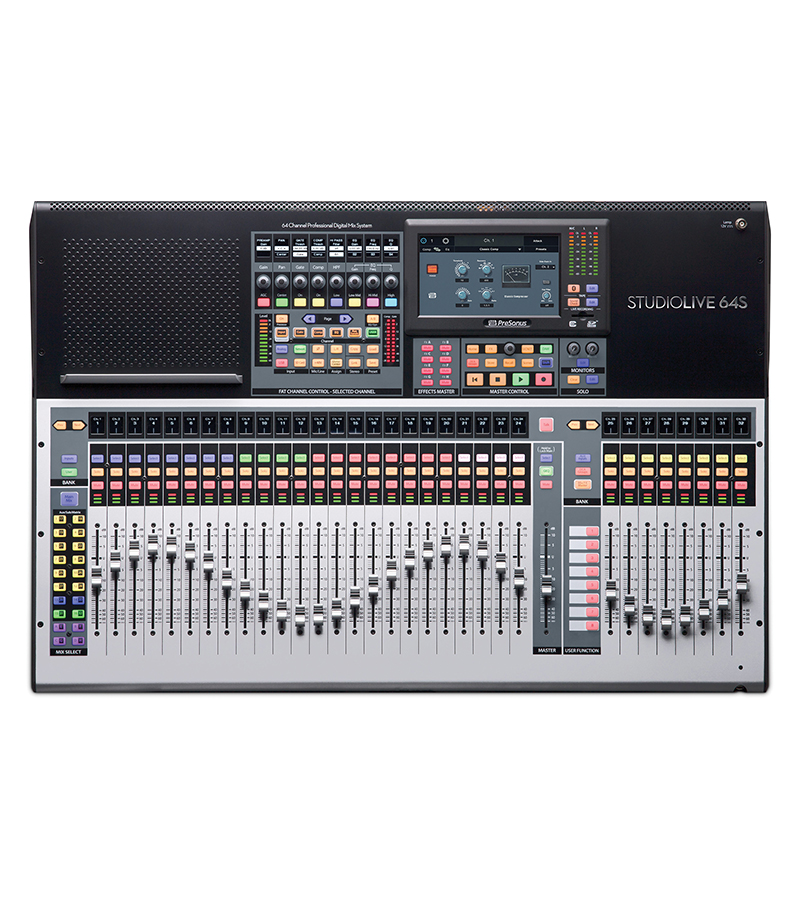
Studer Vista 5SR
studer.ch
Faders: 30 + 2
Mix Inputs: 80 mono/20 stereo
Group: 8 stereo (FOH configuration)
Aux: 10 mono/10 stereo (FOH)
Matrix: 5 mono/5 stereo (FOH)
FX: 12 stereo (w/3 optional Vista FX units) | DCA: 16
Screens: Three Vistonics touch screens
App: Virtual Vista (PC)
Local I/O: 16 + 48 analog XLR, 16 + 16 AES/EBU
Stage Boxes: Compact Stagebox, D21m, D23m
Options: EtherSound, CobraNet, Dante, MADI, ADAT, Aviom
Physical: 59 x 30 x 15 inches, 149 pounds
Additional Model In Series: Vista 1
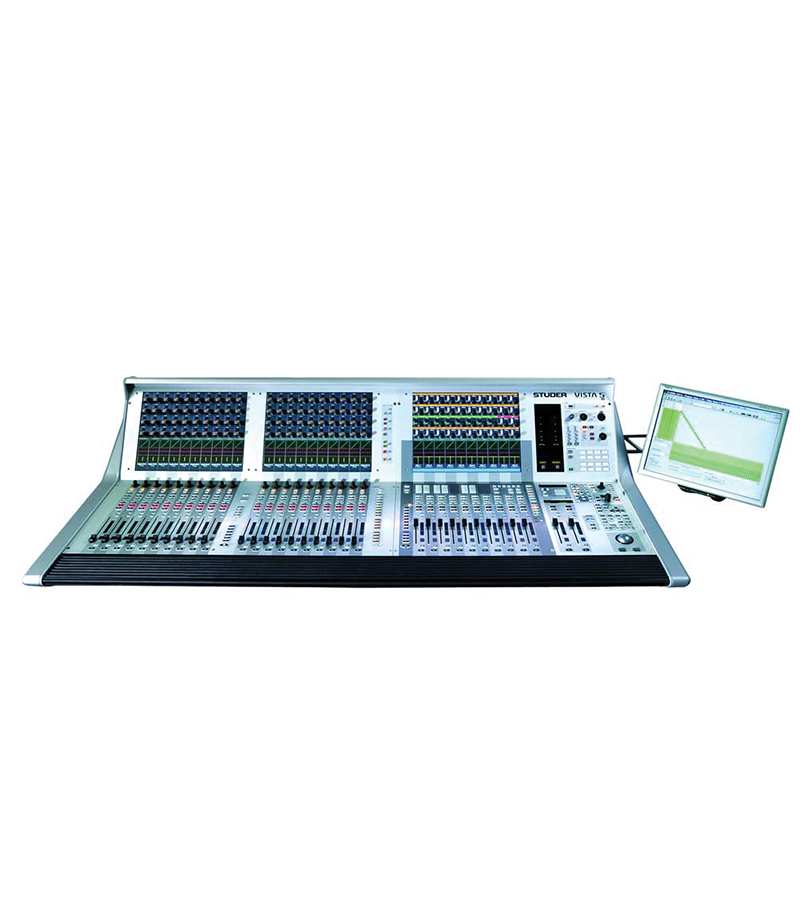
Yamaha TF5
yamahaproaudio.com
Faders: 32 + 1
Mix Inputs: 48 | Aux/Group: 20 | Matrix: N/A
FX: 8 | DCA: 8 | GEQ: 10
Apps: TF StageMix, MonitorMix
Screens: 1 touch screen, also facilitates “Touch & Turn” capability
Local I/O: 32 mic/line (XLR/TRS combo) + 2 stereo line (RCA pin) inputs, 16 (XLR) outputs, 1 expansion slot
Stage Boxes: Tio1608-D Dante-equipped I/O rack
Options: NY64-D Dante expansion card
Also: 34-track recording/ playback, 2-track playback via USB/SSD, Nuendo Live recording software
Physical: 34.1 x 23.6 x 8.9 inches, 44.1 pounds
Additional Models In Series: TF3, TF1
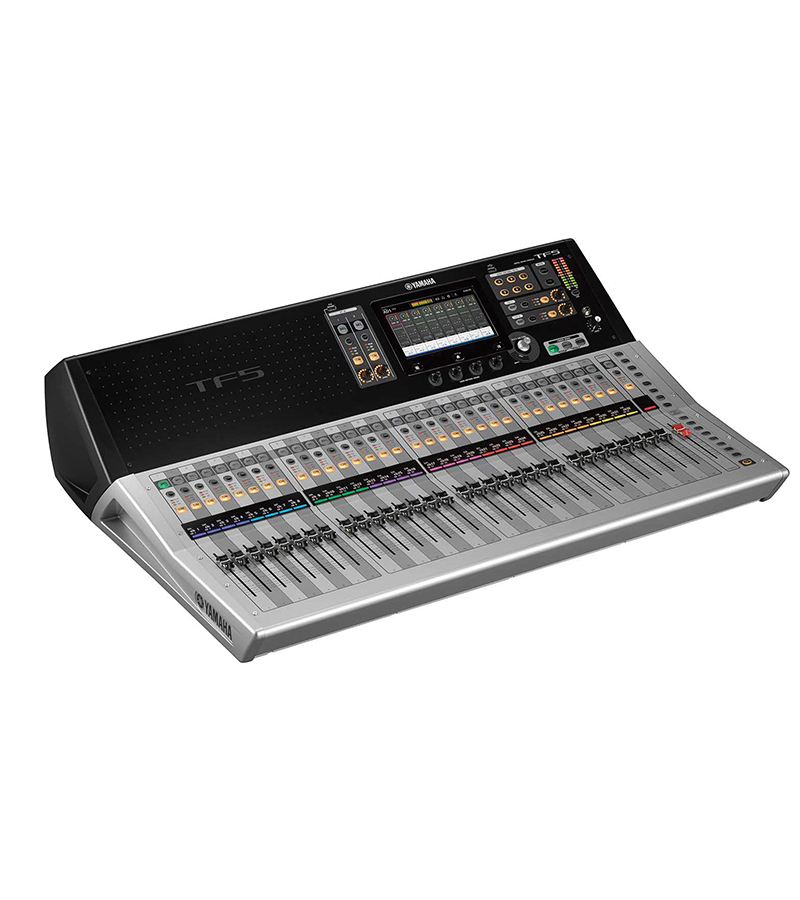
CADAC CDC seven-s
cadac-sound.com
Faders: 36
Mix Inputs: 128
Aux/Group/Matrix: 56
Matrix: Up to 67 x 48
FX: 16 stereo | DCA: 16 | GEQ: 56
Screens: Two 24-inch and one 6-inch touch screen
App: Cadac Remote (iPad)
Local I/O: 8 XLR I/O, 4 AES/EBU I/O, 2 x Cadac MegaCOMMS
Stage Boxes: CDC I/O 6448, CDC I/O 4016, CDC I/O 3216,
CDC MC AES3
Options: MC MADI bridge, MC Dante bridge
Also: Dugan Automixer post fade Insert for Waves, SAM theatrical automation software
Physical: 61 x 30 x 10 inches, 132 pounds
Additional Models In Series: CDC five, CDC six
